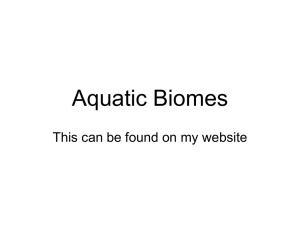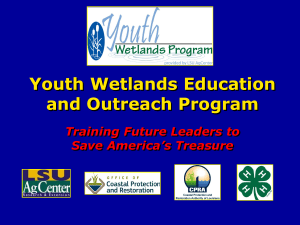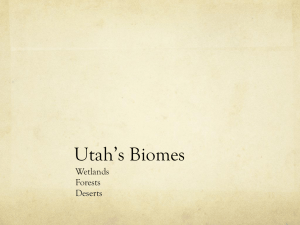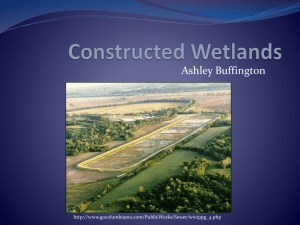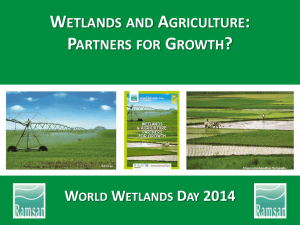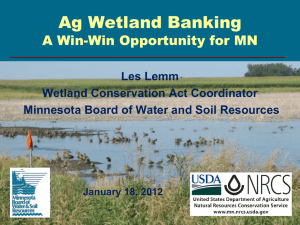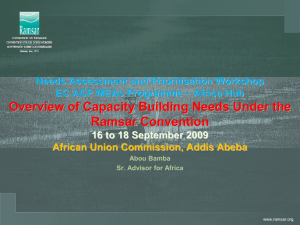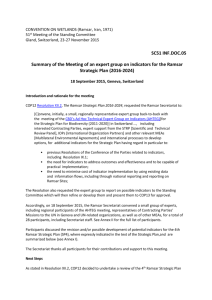pptx file - World Wetlands Day
advertisement
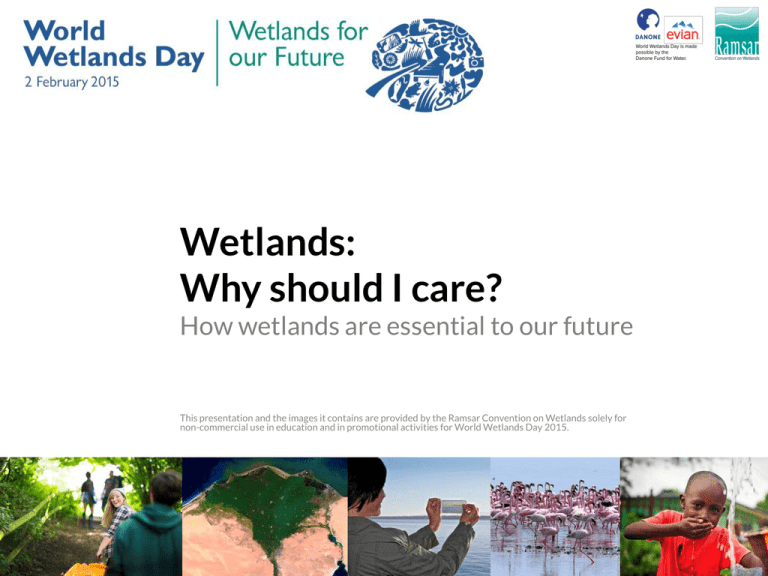
Wetlands: Why should I care? How wetlands are essential to our future This presentation and the images it contains are provided by the Ramsar Convention on Wetlands solely for non-commercial use in education and in promotional activities for World Wetlands Day 2015. What are wetlands anyway? Broad definition: land areas that are flooded with water, either seasonally or permanently Inland wetland types: • Marshes, ponds, lakes, fens, rivers, flood plains and swamps Coastal wetland types: • Mangroves, saltwater marshes, estuaries, lagoons – even coral reefs Man-made wetlands include fish ponds, saltpans, rice paddies Range in size from less than one hectare to the Pantanal in Brazil, Bolivia, and Paraguay; three times the size of Ireland Wetlands provide fresh water for us all Less than 3% of the world‘s water is fresh – the rest is saltwater • • Most of this is frozen Of the available freshwater, the largest share can be found in aquifers At a very basic level, humans require 20-50 litres of water per day • Minimum for drinking, cooking and cleaning needs Almost two billion people in Asia and 380 million EU residents depend on groundwater for their water supply Wetlands help purify and replenish the aquifers humanity depends on Wetlands purify water and filter waste Plants from wetlands can help lessen water pollution • • Absorb some harmful fertilizers and pesticides Retain some heavy metals and toxins from industry Example: Nakivubo Swamp (Kampala, Uganda) • • Filters sewage and industrial effluents for free Treatment plant would cost $2 million per year Interesting fact: one single adult oyster in a tidal flat can filter nearly 200 litres of water per day • Removes sediments and chemical contaminants from coastal waters Wetlands feed humanity Rice, grown in wetland paddies, is the staple diet of nearly three billion people • 20% of the world’s nutritional intake 70% of groundwater extracted is used for irrigation Average human consumes 19kg of fish each year • Much higher per capita consumption in Asia Two-thirds of all commercial fish types depend on coastal wetlands at some point in their lives • • Breeding and spawning grounds Mangroves and estuaries especially important Wetlands are bursting with biodiversity Home to more than 100,000 known freshwater species alone • 257 new species of freshwater fish were discovered in the Amazon between 1999-2009 Essential for many amphibians and reptiles, as well as for bird breeding and migration Individual wetlands often hold ‘endemic species’ • • Forms of life unique to one particular site Lake Baikal in Russia or the Rift Valley lakes of East Africa have many Wetlands fight climate change Peatlands alone cover an estimated 3% of the world’s land area, but they hold 30% of all carbon stored on land • Twice the amount stored in all the world’s forests! In the face of rising sea levels, coastal wetlands reduce the impact of typhoons and tsunamis • • Saltmarshes, mangroves act as buffers ; their roots bind the shoreline and resist erosion Coastal wetlands increase resilience to the impacts of climate change Wet grasslands and peatlands act as natural sponges • • Absorb rainfall, create wide surface pools, ease flooding in river basins Same storage capacity safeguards against drought Wetlands provide sustainable products and livelihoods 61.8 million people earn their living directly from fishing and aquaculture • Including their families, more than 660 million people are dependent on fisheries and fishing for survival Sustainably managed wetlands provide: • • • • • Timber for building Vegetable oil Medicinal plants Stems and leaves for weaving Fodder for animals A future without wetlands? 64 % of the world’s wetlands have disappeared since 1900 • • Loss is much higher in some regions, esp. Asia Measured against 1700, wetland loss is an estimated 87% worldwide Rapid decline means • • Access to fresh water is eroding for one to two billion people worldwide Coastal areas are more exposed to storm surges Biodiversity has also been affected • WWF Living Planet Index: populations of freshwater species declined by 76 % between 1970 and 2010 Wetland Extent Index Jointly–sponsored indicator of decline in wetlands Observed a sampling of more than 1000 wetland sites globally between 1970 and 2008 Average loss in extent of the sites surveyed over this period: 40% Individual sites vary sharply What drives wetland loss and degradation? Wetlands often viewed as wasteland Major changes in land use, specifically increases in: • • • Agriculture Grazing animals Other harvesting such as logging Water diversion through dams, dikes and canalization Infrastructure development, particularly in river valleys and coastal areas Air and water pollution and excess nutrients How can the trend be reversed? Make policies that consider wetlands carefully • • Understanding of ecosystem services that wetlands provide Integrate into land use planning Use all remaining wetland sites wisely • Meet human needs while sustaining biodiversity and other wetland services Restore wetlands that have been degraded Develop financing sources for wetlands conservation Educate others about the benefits of wetlands The Ramsar Convention Intergovernmental treaty on wetlands • • • • Provides the framework for the conservation and wise use 168 Parties (member countries) First modern global environmental agreement Named after Ramsar in Iran, where the Convention was adopted Members commit to: • • • Wise use of all their wetlands Designate suitable wetlands for the list of Wetlands of International Importance (the “Ramsar List”) Cooperate on transboundary wetland systems and shared species Ramsar Sites 2,186 designated Wetlands of International Importance • Status as of 1st October 2014 Cover 208,449,277 hectares • Area slightly larger than Mexico Official list is available online • • • • www.ramsar.org/sites-countries/the-ramsar-sites Downloadable as pdf or . . . Zoom in on world map to find a Ramsar Site near you Click on individual sites for information and link to Ramsar Sites Information Service (RSIS) What can I do as an individual? Experience wetlands for yourself • • • Ramsar Sites list www.ramsar.org/sites-countries/the-ramsar-sites See if there’s a designated Wetland of International Importance in your area Talk with the managers and see if they can use help Educate others • • Host an event Help others understand wetland benefits Organize a wetlands clean-up • • Together in a group, clean-up can be achieved in a few hours Take pictures before and after to highlight the difference What can I do as an individual? Take everyday decisions with the environment in mind • • • • Buy sustainably raised or caught seafood, organic produce and meat Take shorter showers Recycle household trash, make sure batteries do not end up in landfills Select native plants and use organic fertilizer in your own garden Join with others to make a difference • Consult the Ramsar website for partners and link up with their efforts Get involved in World Wetlands Day World Wetlands Day 2015 Celebrated every 2 February to mark the adoption of the Ramsar Convention Ways to get involved: • • Visit a wetland site near you Enter the photo contest (open to contestants aged 15-24) o • • take a photo in a wetland location between 2 February and 2 March 2015 and upload it to www.worldwetlandsday.org Make a pledge to take action for wetlands Educate others about the importance of wetlands Thank you For your attention! Information sources For global freshwater resources: World Business Council for Sustainable Development: Water Fact and Trends, 2009 (p. 3) http://www.wbcsd.org/Pages/EDocument/EDocumentDetails.aspx?ID=137 For share of commercial fish species dependent on wetlands: US Environmental Protection Agency: Wetland Functions and Values (p. 11) http://cfpub.epa.gov/watertrain/pdf/modules/WetlandsFunctions.pdf For human basic daily water requirement: World Health Organization: Domestic Water Quantity, Service Level and Health (p.3) http://www.who.int/water_sanitation_health/diseases/WSH03.02.pdf For number of freshwater species: Millennium Ecosystem Assessment: Ecosystems and Human Well-Being: Wetlands and Water (p. 26) http://www.millenniumassessment.org/documents/document.358.aspx.pdf For dependence on groundwater in Asia: IGES White Paper, Chapter 7: Groundwater and climate change: no longer the hidden resource (p. 160) http://pub.iges.or.jp/modules/envirolib/upload/1565/attach/09_chapter7.pdf For discovery of new freshwater fish species: Worldwide Fund for Nature: Amazon Alive!: A Decade of Discoveries 1999-2009 (p. 1) http://assets.panda.org/downloads/amazon_alive_web_ready_sept23.pdf For dependence on groundwater in EU and EU population: http://ec.europa.eu/environment/water/water-framework/groundwater/resource.htm http://epp.eurostat.ec.europa.eu/statistics_explained/index.php/Population_and_popula tion_change_statistics For Nakivubo swamp: http://www.bloomberg.com/news/2012-06-17/ugandan-swamp-helps-stiglitz-showbenefits-beyond-gdp.html For oyster water filtering capabilities: http://www.cbf.org/about-the-bay/more-than-just-the-bay/creatures-of-thechesapeake/eastern-oyster For rice as proportion of worldwide dietary intake: Food and Agriculture Organization of the UN: Rice and human nutrition fact sheet http://www.fao.org/rice2004/en/f-sheet/factsheet3.pdf For worldwide share of fresh water going to irrigation: www.unwater.org/statistics/statistics-detail/en/c/211813/ For worldwide per capita consumption of fish: Food and Agriculture Organization of the UN: Fish Trade and Human Nutrition (p. 2) http://www.fao.org/cofi/29401-083ff934c3ccfd8576005d8d0c19b04d6.pdf For peatlands and carbon sequestration: TEEB: The Economics of Ecosystems and Biodiversity for Water and Wetlands (p. 11) http://www.ramsar.org/sites/default/files/documents/library/teeb_waterwetlands_report _2013.pdf For fishing industry direct employment: Food and Agriculture Organization of the UN: State of World Fisheries and Aquaculture 2012 (p. 41) http://www.fao.org/docrep/016/i2727e/i2727e.pdf For number of fishing industry dependents: Food and Agriculture Organization of the UN: Fish Trade and Human Nutrition http://www.fao.org/cofi/29401-083ff934c3ccfd8576005d8d0c19b04d6.pdf (p. 2) For the historical loss of wetlands: How much wetland has the world lost? Long-term and recent trends in global wetland area N. Davidson, Marine and Freshwater Research, 2014, 65 (pp.934 &940) http://dx.doi.org/10.1071/MF14173 For loss in freshwater species populations: Worldwide Fund for Nature: Living Planet Report 2014 (p.22) http://wwf.panda.org/about_our_earth/all_publications/living_planet_report/ For the Wetlands Extent Index: CBD: GB04 Technical Report: Progress Towards the Aichi Biodiversity Targets (p.59)

